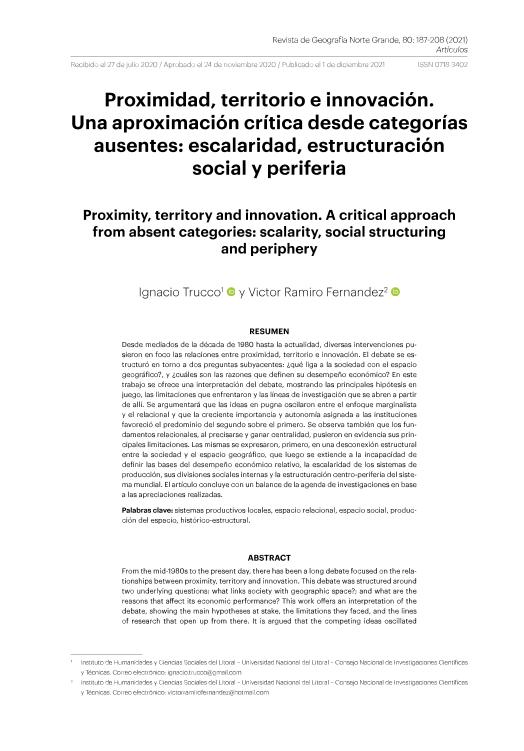Artículo
Desde mediados de la década de 1980 hasta la actualidad, diversas intervenciones pusieron en foco las relaciones entre proximidad, territorio e innovación. El debate se estructuró en torno a dos preguntas subyacentes: ¿qué liga a la sociedad con el espacio geográfico?, y ¿cuáles son las razones que definen su desempeño económico? En este trabajo se ofrece una interpretación del debate, mostrando las principales hipótesis en juego, las limitaciones que enfrentaron y las líneas de investigación que se abren a partir de allí. Se argumentará que las ideas en pugna oscilaron entre el enfoque marginalista y el relacional y que la creciente importancia y autonomía asignada a las instituciones favoreció el predominio del segundo sobre el primero. Se observa también que los fundamentos relacionales, al precisarse y ganar centralidad, pusieron en evidencia sus principales limitaciones. Las mismas se expresaron, primero, en una desconexión estructural entre la sociedad y el espacio geográfico, que luego se extiende a la incapacidad de definir las bases del desempeño económico relativo, la escalaridad de los sistemas de producción, sus divisiones sociales internas y la estructuración centro-periferia del sistema mundial. El artículo concluye con un balance de la agenda de investigaciones en base a las apreciaciones realizadas. From the mid-1980s to the present day, there has been a long debate focused on the relationships between proximity, territory and innovation. This debate was structured around two underlying questions: what links society with geographic space?; and what are the reasons that affect its economic performance? This work offers an interpretation of the debate, showing the main hypotheses at stake, the limitations they faced, and the lines of research that open up from there. It is argued that the competing ideas oscillated between the marginalist and the relational approach and the growing importance and autonomy assigned to the institutions that favor the predominance of the second over the first. It is also observed that the relational foundations, by specifying and gaining centrality, revealed their main limitations. They are expressed in a structural disconnection between society and geographic space, which then extends to the inability to define the bases of relative economic performance, the scale of production systems, their internal social divisions and the center-periphery structuring of world system. The article concludes with a balance of the research agenda based on the assessment made.
Proximidad, territorio e innovación: Una aproximación crítica desde categorías ausentes. Escalaridad, estructuración social y periferia
Título:
Proximity, territory and innovation: A critical approach from absent categories. Scalarity, social structuring and periphery
Fecha de publicación:
12/2021
Editorial:
Pontificia Universidad Católica de Chile
Revista:
Revista de Geografía Norte Grande
ISSN:
0379-8682
e-ISSN:
0718-3402
Idioma:
Español
Tipo de recurso:
Artículo publicado
Clasificación temática:
Resumen
Archivos asociados
Licencia
Identificadores
Colecciones
Articulos(IHUCSO LITORAL)
Articulos de INSTITUTO DE HUMANIDADES Y CIENCIAS SOCIALES DEL LITORAL
Articulos de INSTITUTO DE HUMANIDADES Y CIENCIAS SOCIALES DEL LITORAL
Citación
Trucco, Ignacio Tomas; Fernández, Víctor Ramiro; Proximidad, territorio e innovación: Una aproximación crítica desde categorías ausentes. Escalaridad, estructuración social y periferia; Pontificia Universidad Católica de Chile; Revista de Geografía Norte Grande; 80; 12-2021; 187-208
Compartir




